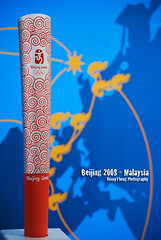 Beijing 2008 (Photo credit: kennytyy)Emission controls versus meteorological conditions in determining aerosol concentrations in Beijing during the 2008 Olympic Games (15 page pdf, Y. Gao, X. Liu, C. Zhao, and M. Zhang, Atmos. Chem. Phys., Dec. 28, 2011)
Beijing 2008 (Photo credit: kennytyy)Emission controls versus meteorological conditions in determining aerosol concentrations in Beijing during the 2008 Olympic Games (15 page pdf, Y. Gao, X. Liu, C. Zhao, and M. Zhang, Atmos. Chem. Phys., Dec. 28, 2011)Also discussed here: Weather Deserves Medal for Clean Air During 2008 Olympics (Science Daily, Dec. 28, 2011)
And here: Impact of Changes in Transportation and Commuting Behaviors During the 1996 Summer Olympic Games in Atlanta on Air Quality and Childhood Asthma (9 page pdf, Michael S. Friedman, Kenneth E. Powell, Lori Hutwagner, LeRoy M. Graham,W. Gerald Teague, Journal American Medical Association, Feb. 21, 2001)
Credit for the surprisingly good air quality at the 2008 Beijing Olympics has been given to the Chinese government for various steps taken to reduce pollution sources, especially vehicle emissions, during and before the games- as they had been, with equally good health results, at the Atlanta, USA Games in 1996. A more detailed analysis of the added effect of meteorology, summarized in the article under review, shows that favourable winds and well-timed rainfall had at least as much to do with the results. The lesson to be learned from this, especially for those cities with unhealthy air, with or without Olympic fever, is that major reductions in pollution and improvements in health are possible with enough government will to engage public support.

Key Quotes:
“PM10 .. is reported to be the major cause of air pollution in Beijing on about 90% of days from 1999 to 2005 ..and its concentration exceeds the China’s Grade-2 Standard (daily averaged concentration of PM10 of 150 μgm−3) on 30% of the days each year…emissions over the northwest and southwest to Beijing contribute 39% and 15 %, respectively, to the particle matter concentrations over urban Beijing”
“A series of emission control measures were undertaken in Beijing and the adjacent provinces in China during the 2008 Beijing Olympic Games on 8–24 August 2008..Before the full-scale control (pre-20 July 2008), heavy industrial polluters (e.g. the Capital Steel Company) were relocated, and 50% of government cars were not allowed to drive in Beijing after 23 June 2008”
“During the full-scale control (from 20 July to 19 September 2008), first, the odd/even license plate number rule was applied on personal vehicles in Beijing; second, stricter control was applied on vehicles entering Beijing; third, the production of some factories that can cause air pollution was limited or even stopped.. In addition, extra 20% government cars were not allowed to drive in Beijing, some outdoor constructions were stopped, and usages of coal-burning facilities were restricted”
“on-road concentrations of NOx, SO2, carbon monoxide (CO), and BC were reduced by 41 %, 70 %, 54 %, and 12 %, respectively during the Olympics”
“In addition to the emission controls, the weather was very important in reducing pollution. You can see the rain washing pollution out of the sky and wind transporting it away from the area….while some pollution got washed out by rain or fell out of the sky, most of it got blown away by wind”
“modeled concentrations of aerosol species (sulfate, nitrate, ammonium, black carbon, organic carbon, total particulate matter) in Beijing were decreased by 30–50% during the Olympic period compared to the other periods in July and August in 2008 and the same period in 2007”
Related articles
- Traveling to Beijing? Beware the pollution (gadling.com)
- Racing Up (and Down) the Performance Index (green.blogs.nytimes.com)
- Severe Beijing smog -- or fog? -- leads to long airport delays - Los Angeles Times (latimesblogs.latimes.com)
- Snow Falling on Smog: Is There Any Hope for Beijing's Air? (globalspin.blogs.time.com)
- Pollution Update : China to cut pollutant emissions by over 30% (environmentaleducationuk.wordpress.com)
- Airing China (deegeesbb.wordpress.com)

No comments:
Post a Comment